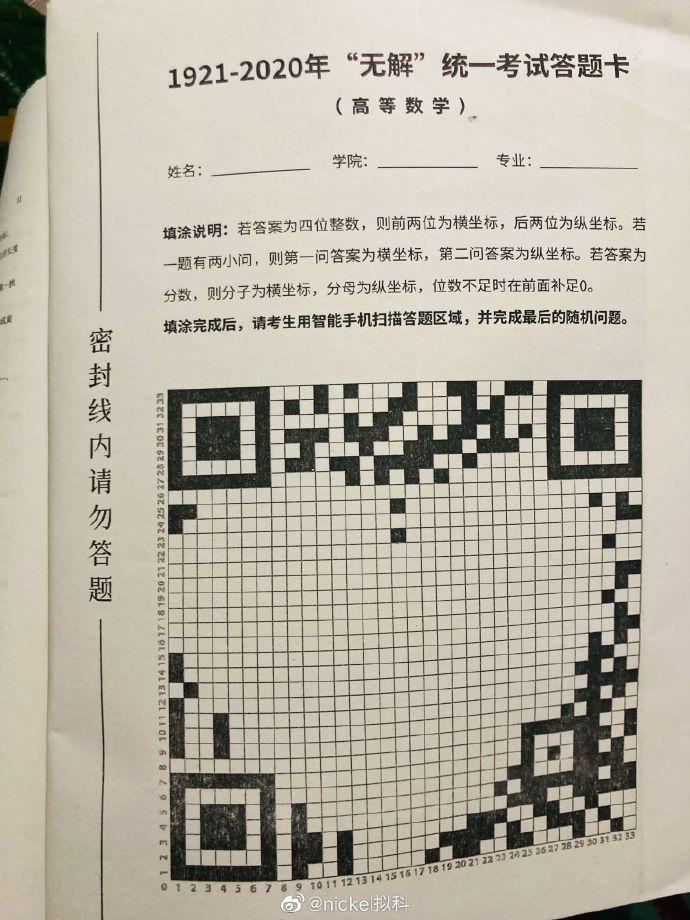- 1这个防火墙实验配置案例,堪称模板!_如何简单配置防火墙
- 2AES加密算法详解(图文解释)
- 32024年最全Google 面试六轮游,结果还是没过!Google面试真题分享,2024金九银十面试季
- 4为Atmega328P定制bootloader 添加自己的板卡到Arduino IDE
- 5Python: ImportError: Bad git executable_import error bad git
- 6华为HCIA认证考试简介_hcia考试
- 7Caused by: org.springframework.amqp.AmqpException: No method found for class [B
- 8这10款VS Code神仙插件,嵌入式程序员必备_vs插件
- 9夜神模拟器连接AndroidStudio_夜神模拟器怎么连as
- 10数据统计与分析基础 实验四 机器学习算法建模与求解
【Java】2021 RoboCom 机器人开发者大赛-高职组(初赛)题解_2021 robocom 世界机器人开发者大赛-高职组(初赛java
赞
踩
7-1 机器人打招呼

机器人小白要来 RoboCom 参赛了,在赛场中遇到人要打个招呼。请你帮它设置好打招呼的这句话:“ni ye lai can jia RoboCom a?”。
输入格式:
本题没有输入。
输出格式:
在一行中输出 ni ye lai can jia RoboCom a?。
输入样例:
无
- 1
输出样例:
ni ye lai can jia RoboCom a?
- 1
Solution:
print("ni ye lai can jia RoboCom a?")
- 1
7-2 人脸识别

人脸识别是基于人的脸部特征信息进行身份识别的技术,包括人脸图像采集及检测、图像预处理、特征提取以及匹配与识别四大部分。本题请你为机器人警察实现一个非常简单的特征匹配算法,帮助查找罪犯:即给定数据库中存储的某罪犯的双眼间距、鼻梁长度、唇宽,然后与面前这个人的特征数据进行匹配,判断其是否该罪犯。
输入格式:
输入在第一行中给出罪犯的双眼间距 L0、鼻梁长度 L1、唇宽 L2、以及允许的误差范围 T。第二行中给出当前被检测的人的双眼间距 l0、鼻梁长度 l1、唇宽 l2。所有数字均为毫米为单位的长度,是不超过 100 的正整数,同行数字间以空格分隔。
输出格式:
首先在第一行中输出两个人脸特征的误差,格式为:
Diff = D0, D1, D2
- 1
其中 D0=L0−l0,D1=L1−l1,D2=L2−l2。如果三项误差的绝对值之和不超过 T,则在第二行输出 Yes,否则输出 No。
输入样例 1:
23 60 54 3
23 59 56
- 1
- 2
输出样例 1:
Diff = 0, 1, -2
Yes
- 1
- 2
输入样例 2:
23 60 54 3
24 59 56
- 1
- 2
输出样例 2:
Diff = -1, 1, -2
No
- 1
- 2
Solution:
import java.io.BufferedReader; import java.io.IOException; import java.io.InputStreamReader; public class Main { public static void main(String[] args) throws IOException { BufferedReader in = new BufferedReader(new InputStreamReader(System.in)); String[] input = in.readLine().split(" "); int L0 = Integer.parseInt(input[0]); int L1 = Integer.parseInt(input[1]); int L2 = Integer.parseInt(input[2]); int T = Integer.parseInt(input[3]); input = in.readLine().split(" "); int l0 = Integer.parseInt(input[0]); int l1 = Integer.parseInt(input[1]); int l2 = Integer.parseInt(input[2]); int D0 = L0 - l0; int D1 = L1 - l1; int D2 = L2 - l2; System.out.printf("Diff = %d, %d, %d\n", D0, D1, D2); if (Math.abs(D0) + Math.abs(D1) + Math.abs(D2) <= T) { System.out.println("Yes"); } else { System.out.println("No"); } } }
- 1
- 2
- 3
- 4
- 5
- 6
- 7
- 8
- 9
- 10
- 11
- 12
- 13
- 14
- 15
- 16
- 17
- 18
- 19
- 20
- 21
- 22
- 23
- 24
- 25
- 26
- 27
7-3 月份输出
本题要求你写一个程序帮助小朋友学习用英语描述月份。已知英文的 12 个月份为:
- 一月:January
- 二月:February
- 三月:March
- 四月:April
- 五月:May
- 六月:June
- 七月:July
- 八月:August
- 九月:September
- 十月:October
- 十一月:November
- 十二月:December
输入格式:
输入包括若干行,每一行里给出一个整数。
输出格式:
对每一行的输入,如果该整数在 1 到 12 之间,则在一行中输出这个数字对应的英文月份单词;否则输出 ? 并结束程序。题目保证程序会结束。
输入样例:
10
5
28
-1
- 1
- 2
- 3
- 4
输出样例:
October
May
?
- 1
- 2
- 3
Solution:
import java.io.BufferedReader; import java.io.IOException; import java.io.InputStreamReader; public class Main { public static void main(String[] args) throws IOException { BufferedReader in = new BufferedReader(new InputStreamReader(System.in)); int n = Integer.parseInt(in.readLine()); String[] m = {"", "January", "February", "March", "April", "May", "June", "July", "August", "September", "October", "November", "December"}; while (true) { if (n > 12 || n < 1) { System.out.println("?"); break; } else { System.out.println(m[n]); } n = Integer.parseInt(in.readLine()); } } }
- 1
- 2
- 3
- 4
- 5
- 6
- 7
- 8
- 9
- 10
- 11
- 12
- 13
- 14
- 15
- 16
- 17
- 18
- 19
- 20
- 21
7-4 字母串
英语老师要求学生按照如下规则写一串字母:
- 如果写了某个大写字母,下一个就必须写同个字母的小写,或者写字母表中下一个字母的大写;
- 如果写了某个小写字母,下一个就必须写同个字母的大写,或者写字母表中前一个字母的小写;
- 当然也可以什么都不写,就结束这个字母串。
例如 aAaABCDdcbBC 就是一个合法的字母串;而 dEFfeFGhI 就是非法的。注意 a 没有前一个字母, Z 也没有下一个字母。
现在面对全班学生交上来的作业,老师请你写个程序自动批改。
输入格式:
输入在第一行给出一个不超过 100 的正整数 N。随后 N 行,每行给出一位学生的作业,即仅由英文字母组成的非空字母串,长度不超过 2×106。
输出格式:
对每位学生的作业,如果正确就在一行中输出 Y,否则输出 N。
输入样例:
2
aAaABCDdcbBC
dEFfeFGhI
- 1
- 2
- 3
输出样例:
Y
N
- 1
- 2
Solution:
import java.io.BufferedReader; import java.io.IOException; import java.io.InputStreamReader; public class Main { public static void main(String[] args) throws IOException { BufferedReader in = new BufferedReader(new InputStreamReader(System.in)); int n = Integer.parseInt(in.readLine()); label: for (int i = 0; i < n; i++) { char[] chars = in.readLine().toCharArray(); for (int j = 0; j < chars.length - 1; j++) { if (chars[j] >= 'A' && chars[j] <= 'Z') { if (chars[j] == 'Z' && chars[j + 1] != 'z') { System.out.println("N"); continue label; } if (chars[j + 1] != (char) (chars[j] + 32) && chars[j + 1] != (char) (chars[j] + 1)) { System.out.println("N"); continue label; } } else if (chars[j] >= 'a' && chars[j] <= 'z') { if (chars[j] == 'a' && chars[j + 1] != 'A') { System.out.println("N"); continue label; } if (chars[j + 1] != (char) (chars[j] - 32) && chars[j + 1] != (char) (chars[j] - 1)) { System.out.println("N"); continue label; } } } System.out.println("Y"); } } }
- 1
- 2
- 3
- 4
- 5
- 6
- 7
- 8
- 9
- 10
- 11
- 12
- 13
- 14
- 15
- 16
- 17
- 18
- 19
- 20
- 21
- 22
- 23
- 24
- 25
- 26
- 27
- 28
- 29
- 30
- 31
- 32
- 33
- 34
- 35
- 36
7-5 增一数
若一个正整数有 2n 个数位,后 n 位组成的数恰好比前 n 位组成的数大 1,则这个数称为增一数。例如 34、2526、233234 都是增一数。如果这个数还是某个数的平方,则称为平方增一数。你的任务就是判断任一给定正整数是否平方增一数。
输入格式:
输入在第一行中给出一个正整数 N(≤100),随后 N 行,每行给出一个不超过 231 的待判定的正整数。
输出格式:
对每个待判定的正整数,在一行中输出判定结果:如果是平方增一数,则输出 2;如果只是普通增一数,则输出 1;如果不是增一数,则输出 0。
输入样例:
3
528529
2324
5678
- 1
- 2
- 3
- 4
输出样例:
2
1
0
- 1
- 2
- 3
Solution:
import java.io.BufferedReader; import java.io.IOException; import java.io.InputStreamReader; public class Main { public static void main(String[] args) throws IOException { BufferedReader in = new BufferedReader(new InputStreamReader(System.in)); int n = Integer.parseInt(in.readLine()); for (int i = 0; i < n; i++) { String s = in.readLine(); long length = s.length() / 2; long num = Long.parseLong(s); long x = (long) Math.pow(10, length); long left = num / x; long right = num % x; if (right - left == 1) { if (Double.toString(Math.sqrt(num)).matches("\\d+[.]0")) { System.out.println(2); } else { System.out.println(1); } } else { System.out.println(0); } } } }
- 1
- 2
- 3
- 4
- 5
- 6
- 7
- 8
- 9
- 10
- 11
- 12
- 13
- 14
- 15
- 16
- 17
- 18
- 19
- 20
- 21
- 22
- 23
- 24
- 25
- 26
- 27
- 28
7-6 答题卡

新浪微博上有网友发文称:“朋友买了本玻尔 X 海森堡的物理大佬同人本,送了 300 道高数题。更绝的是,要做完题目按照答案涂答题卡,涂出一个二维码,扫描二维码才能看到特典,做错了就看不到了……”那张传说中的答题卡如下图所示:若答案为 4 位整数(位数不足时在前面补足 0),则前两位为横坐标,后两位为纵坐标。若一题有两小问,则第一问答案为横坐标,第二问答案为纵坐标。若答案为分数,则分子为横坐标,分母为纵坐标。

本题就请你根据答案帮助读者填写答题卡。
输入格式:
输入首先在第一行给出两个正整数:2<n≤90 为二维码的规模,即二维码是由 n×n 个小方块组成的大方块,左下角的小方块对应坐标 (1, 1),右上角的小方块对应坐标 (n, n);另一个 m(<n2)是答案的个数。最后 m 行,每行按以下格式之一给出一题的答案:或者是一个不超过 4 位的整数;或者是两小问的答案 答案1;答案2;或者是一个分数 分子/分母。这里保证每个答案都可以解析为一个二维码中的方块位置(即不存在超出二维码范围的坐标)。
输出格式:
输出 n 行,每行 n 个字符,空格用 . 表示,涂了答案的黑格用 # 表示。
输入样例:
5 7
205
3;2
4/5
101
3;3
4/3
5;1
- 1
- 2
- 3
- 4
- 5
- 6
- 7
- 8
输出样例:
.#.#.
.....
..##.
..#..
#...#
- 1
- 2
- 3
- 4
- 5
Solution:
import java.io.BufferedReader; import java.io.IOException; import java.io.InputStreamReader; public class Main { public static void main(String[] args) throws IOException { BufferedReader in = new BufferedReader(new InputStreamReader(System.in)); String[] input = in.readLine().split(" "); int n = Integer.parseInt(input[0]); int m = Integer.parseInt(input[1]); int[][] code = new int[n + 1][n + 1]; for (int i = 0; i < m; i++) { String s = in.readLine(); if (s.matches("\\d+")) { s = String.format("%04d", Integer.parseInt(s)); int length = s.length() / 2; int x = Integer.parseInt(s.substring(0, length)); int y = Integer.parseInt(s.substring(length)); code[n + 1 - y][x] = 1; } else { String[] x = s.split("\\W"); code[n + 1 - Integer.parseInt(x[1])][Integer.parseInt(x[0])] = 1; } } for (int i = 1; i < code.length; i++) { for (int j = 1; j < code[i].length; j++) { if (code[i][j] == 1) { System.out.print("#"); } else { System.out.print("."); } } System.out.println(); } } }
- 1
- 2
- 3
- 4
- 5
- 6
- 7
- 8
- 9
- 10
- 11
- 12
- 13
- 14
- 15
- 16
- 17
- 18
- 19
- 20
- 21
- 22
- 23
- 24
- 25
- 26
- 27
- 28
- 29
- 30
- 31
- 32
- 33
- 34
- 35
- 36
- 37
7-7 救救倒霉鬼
倒霉鬼抗着一大箱银行票据去邮寄,却不慎掉进了西湖…… 他奋力游上岸并且顺便抢救了一些票据。但还是有一些票据落到了西湖底必须补做…… 于是请你写程序帮帮倒霉鬼,给他列出来需要重新补做的票据有哪些?
输入格式:
输入首先给出全部一箱票据的信息:在第一行给出不超过 105 的正整数 N,随后 N 行,每行给出一张票据的编号。题目保证编号不重复。
随后是抢救回来的票据的信息,首先是一个小于 N 的非负整数 M,随后 M 行,每行给出一份抢救回来的票据的编号。题目保证编号存在。
编号为长度不超过 12 的、由英文字母和数字组成的字符串。
输出格式:
按字典序递减输出丢失的票据的编号,每个编号占一行。
输入样例:
5
A20190289
B20018372
A19873001
T27346900
B00247834
3
T27346900
A19873001
B20018372
- 1
- 2
- 3
- 4
- 5
- 6
- 7
- 8
- 9
- 10
输出样例:
B00247834
A20190289
- 1
- 2
Solution:
import java.io.BufferedReader; import java.io.IOException; import java.io.InputStreamReader; import java.util.*; public class Main { public static void main(String[] args) throws IOException { BufferedReader in = new BufferedReader(new InputStreamReader(System.in)); int n = Integer.parseInt(in.readLine()); Set<String> tickets = new TreeSet<>(Comparator.reverseOrder()); for (int i = 0; i < n; i++) { tickets.add(in.readLine()); } int m = Integer.parseInt(in.readLine()); Set<String> find = new HashSet<>(); for (int i = 0; i < m; i++) { find.add(in.readLine()); } tickets.removeAll(find); StringBuilder sb = new StringBuilder(); for (String ticket : tickets) { sb.append(ticket).append("\n"); } System.out.print(sb); } }
- 1
- 2
- 3
- 4
- 5
- 6
- 7
- 8
- 9
- 10
- 11
- 12
- 13
- 14
- 15
- 16
- 17
- 18
- 19
- 20
- 21
- 22
- 23
- 24
- 25
- 26



